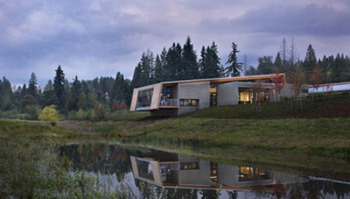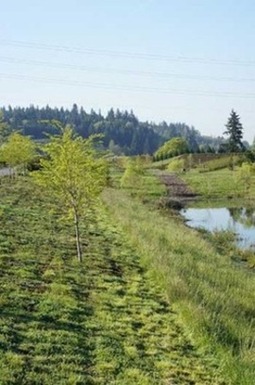Imagine a sewage treatment facility where people get married, surrounded by acres of restored habitat with ponds and fish-friendly wetlands. It sounds far-fetched but it’s reality in Snohomish County, Washington. By Jared Green.
 Brightwater is a modern sewage treatment facility that enhances the environment and increases quality of life for local communitiesWashington, 21 October 2015- Michael Popiwny is a visionary landscape architect who managed a $1 billion project for a wastewater treatment plant - one that successfully demonstrates how sewage can become an asset instead of a drain on communities and the environment.
Brightwater is a modern sewage treatment facility that enhances the environment and increases quality of life for local communitiesWashington, 21 October 2015- Michael Popiwny is a visionary landscape architect who managed a $1 billion project for a wastewater treatment plant - one that successfully demonstrates how sewage can become an asset instead of a drain on communities and the environment.
Popiwny says the key to success was an interdisciplinary management, design, and construction team that was highly responsive to community feedback and deeply sensitive to environmental concerns. And it's self funding; as new people are attracted to the quality of life in the area, they move in and pay a $4,000 – $8,000 sewer hook-up fee. “The fact that new people were paying for the system helped us to sell it to the community,” says Popiwny.
Massive machine
 Meadows and wetlands trap and store clean rainwater which are then channelled into salmon migratory streams.Brightwater is a 114-acre site that started operations in 2011, and cleans sewage from around four million households. It has 20 km of underground pipes feeding sewage water to the plant from the surrounding wealthy residential area that are piped into the largest membrane bioreactor system in North America. This produces water that is 70% cleaner than conventional approaches, so it can be piped to a 200 metre-deep outfall pipe several kilometres out into the Puget sound. Excess solids are extracted and sold to local farms and orchards at very low cost.
Meadows and wetlands trap and store clean rainwater which are then channelled into salmon migratory streams.Brightwater is a 114-acre site that started operations in 2011, and cleans sewage from around four million households. It has 20 km of underground pipes feeding sewage water to the plant from the surrounding wealthy residential area that are piped into the largest membrane bioreactor system in North America. This produces water that is 70% cleaner than conventional approaches, so it can be piped to a 200 metre-deep outfall pipe several kilometres out into the Puget sound. Excess solids are extracted and sold to local farms and orchards at very low cost.
But Brightwater is more than a processing plant. It is a treatment facility, environmental education and community center, and ecological system rolled into one. Popiwny describes the design and construction process: “We had separate contracts for the engineering and design teams. We needed the strongest engineering team and the strongest landscape architecture team, and in the end we combined their efforts in the final design," he says.
As the processing facilities were dug out of the landscape, the excess soil was turned into “decorative, geometric landforms" that by being used locally took thousands of trucks off the highway and saved lots of carbon, says Popiwny.
The top end of Brightwater (that was once an auto garage) now features an elaborate system of forests, meadows, raingardens, wetlands, and ponds that hold and clean rainwater before directing it to the streams that salmon use.
Restored Ruins
 Complex habitat restoration involved the use of 15 different rock types to construct stream corridorsThe process of restoring the habitat and turning into a publicly-accessible park was complex, involving stream and wetland biologists, who guided ecological decisions. The team used 15 different types of rocks to create two different stream corridors that empty into ponds where salmon rest on their uphill climb to the places where they spawn.
Complex habitat restoration involved the use of 15 different rock types to construct stream corridorsThe process of restoring the habitat and turning into a publicly-accessible park was complex, involving stream and wetland biologists, who guided ecological decisions. The team used 15 different types of rocks to create two different stream corridors that empty into ponds where salmon rest on their uphill climb to the places where they spawn.
To help restore the wetland, Popiwny and his team decided on a community outreach project. Kids from the area helped plant over 20,000 native willows to create community buy-in and grow a sense of greater investment in the success of the project. "We had about 4-6 busloads of kids from the surrounding area every week," says Popiwny.
The site also features an environmental education center, designed and built to LEED Platinum level that is often used for non-profit organization meetings and community meetings. It also houses an environmental education center, which features flexible classrooms for groups of all ages to enable hands-on learning about the water cycle.
The parkland, environmental education and community centers were all part of $149 million set aside by the local authorities as part of a “mitigation budget.” According to Popiwny, providing these facilities also helped promote the facility to local people - who might otherwise have objected to a conventional sewage treatment plant.
"Budgeting this upfront meant saving money over the long run," he says. But despite the community buy-in, the Brightwater project was sued by local sewer operators who argued the project “spent too much on mitigation!” Luckily, the State Supreme Court sided with Brightwater and dismissed the claims.
Checking culture
“But there need to be multiple checks as these projects can affect communities," says Popiwny. Indeed, he adds, locals benefited from the opposition as it pushed the designers towards a higher performance, even though it made it more expensive through the implementation of technical fail-safe systems. These include multiple, isolated ponds to separate acid or bases if there is an overflow or accident caused by an earthquake. All engineering pipes and systems are also designed to withstand high levels of seismic activity.
 Recreational parks for the community to enjoy Its not all mechanics and engineering though. Spread throughout the site is public art, as part of the state’s cultural programme. "We realized that this place needed to be beautiful. We need it to look great as well as be very [functionally] designed," says Popiwny. The results are there to see.
Recreational parks for the community to enjoy Its not all mechanics and engineering though. Spread throughout the site is public art, as part of the state’s cultural programme. "We realized that this place needed to be beautiful. We need it to look great as well as be very [functionally] designed," says Popiwny. The results are there to see.
Nestled in an environmental wilderness, with some 70 acres of trails and parks open to the public, Brightwater has managed to become a welcoming place that has restored the ecological function of the landscape - as well as process 136 million litres of wastewater a day for 15 million local household users.
For more info on Brightwater go to: http://www.kingcounty.gov/environment/wtd.aspx